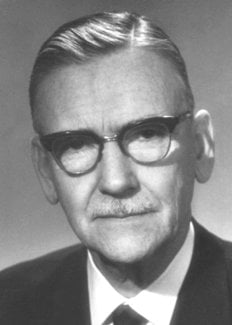Ulf von Euler
Biographical

Ulf S. von Euler was born in Stockholm on February 7th, 1905, as the second son of Hans von Euler-Chelpin and Astrid Cleve. His father was born in Augsburg, Germany, as the only son of general Rigas von Euler-Chelpin. Hans von Euler-Chelpin received the Nobel Prize for Chemistry in 1929. Ulf’s mother was the daughter of Per Teodor Cleve, who was Professor of Chemistry in Uppsala, and the discoverer of the elements thulium and holmium. Astrid Cleve received her Ph. D. in botany and later devoted most of her scientific activities to diatomes and to geology and obtained the title of professor in 1955.
After school years in Stockholm and in Karlstad, Ulf von Euler entered the Karolinska Institute as a medical student in 1922. The scientific atmosphere at home and the regular opportunities to meet scientists – Svante Arrhenius (Nobel Prize for Chemistry in 1903) was his godfather – had, no doubt, a great part in his growing interest in research. This was facilitated but never enforced upon him by his parents. After a period of study with Robin Fåhraeus (a pioneer in blood sedimentation and rheology) von Euler began some research work on his own and he was much encouraged by a prize given for a study on vasoconstrictor properties of fever blood.
From 1926 he worked as assistant in G. Liljestrand’s Department of Pharmacology, where he produced his thesis in 1930, followed by an appointment as Assistant Professor in Pharmacology in the same year.
Aided by the continuous support of Liljestrand, von Euler had the good fortune of obtaining a Rockefeller Fellowship for studies abroad (1930-1931) with H. H. Dale in London, I. de Burgh Daly in Birmingham, C. Heymans in Ghent and G. Embden in Frankfurt. This period of diversified studies in Physiology and Pharmacology provided an invaluable basis for further research. Having had the good luck of discovering an active biological factor in intestinal extracts («Substance P»), further developed with J. H. Gaddum in Dale’s laboratory, von Euler’s interest, soon after his return home, turned in that direction and led subsequently to the findings of prostaglandin and vesiglandin (1935), piperidine (1942) and noradrenaline (1946).
In A. V. Hill‘s laboratory in London, von Euler obtained some insight into problems and methodology of biophysics (1934). Expert teaching in the subjects of neuromuscular transmission was given by G. L. Brown in London (1938). Various aspects of endocrinology and experimental renal hypertension were later studied with E. Braun-Menéndez in B. A. Houssay‘s laboratory in Buenos Aires in 1946-1947.
After a period from 1930 to 1939 as Assistant Professor, von Euler was appointed Professor of Physiology at the Karolinska Institute, a post which he has held until 1971. Conditions for work were improved by the transfer from the old site of the Karolinska Institute to modern laboratories in the new premises just outside Stockholm. Experimental work was greatly facilitated by generous support from the Medical Research Council (after 1950) but also from private funds and the pharmaceutical industry, as well as from research funds in the United States of America.
After the identification of noradrenaline as the adrenergic neurotransmitter in 1946, most of von Euler’s research work has been devoted to this subject. Its distribution in nerves and organs, its excretion during various physiological and pathological conditions and its quantitation have been studied in his laboratory. The finding that the transmitter was stored in subcellular particles (with his late colleague N-Å. Hillarp) gave a new direction to the research, and problems concerning uptake, storage and release from nerve granules as well as the neurotransmission process have been the main research subject since 1958. A large number of students, research assistants and research associates have taken part in these studies.
During the years 1953 to 1960 Ulf von Euler was a Member of the Nobel Committee for Physiology or Medicine and from 1961 to 1965 he served as Secretary of the Committee. In 1965 Professor von Euler was appointed Chairman of the Board of the Nobel Foundation.
From 1965 to 1971 he served as Vice-President of the International Union of Physiological Sciences.
Professor von Euler was awarded the Gairdner Prize (Canada) in 1961, the Jahre Prize (Norway) 1965, the Stouffer Prize (U.S.A.) in 1967, Carl Ludwig Medaille (Germany) 1953, Schmiedeberg Plaquette (Germany) 1969, La Madonnina (Italy) 1970.
Professor von Euler is a Member of the Royal Academies of Sciences in Stockholm and in Copenhagen, the Leopoldina Academy (Halle), Real Academia de Medicina in Barcelona and The American Philosophical Society. Honorary Member of The American College of Physicians, Council on Clinical Cardiology of the American Heart Association, Swedish College of Physicians, Italian Pharmacological Society, Swedish Endocrinological Society, and the Aeromedical Society.
He is Dr. h. c. at the Universities of Umeå, Rio de Janeiro, Dijon, Ghent, Tübingen, Buenos Aires, Edinburgh, Madrid, Gustavus Adolphus College.
From 1930 to 1957, Ulf von Euler was married to Jane Sodenstierna, they had four children: Hans Leo, scientist administrator at the National Institutes of Health, Bethesda, U.S.A.; Johan Christopher, anesthesiologist, Serafimer Hospital, Stockholm; Ursula Katarina, B. A. Assistant in the Department of History of Arts, University of Stockholm; and Marie Jane, Chemical Engineer, Melbourne, Australia.
Since 1958 Ulf von Euler is married to countess Dagmar Cronstedt.
This autobiography/biography was written at the time of the award and first published in the book series Les Prix Nobel. It was later edited and republished in Nobel Lectures. To cite this document, always state the source as shown above.
Ulf von Euler died on March 9, 1983.
Nobel Prizes and laureates
Six prizes were awarded for achievements that have conferred the greatest benefit to humankind. The 14 laureates' work and discoveries range from quantum tunnelling to promoting democratic rights.
See them all presented here.
